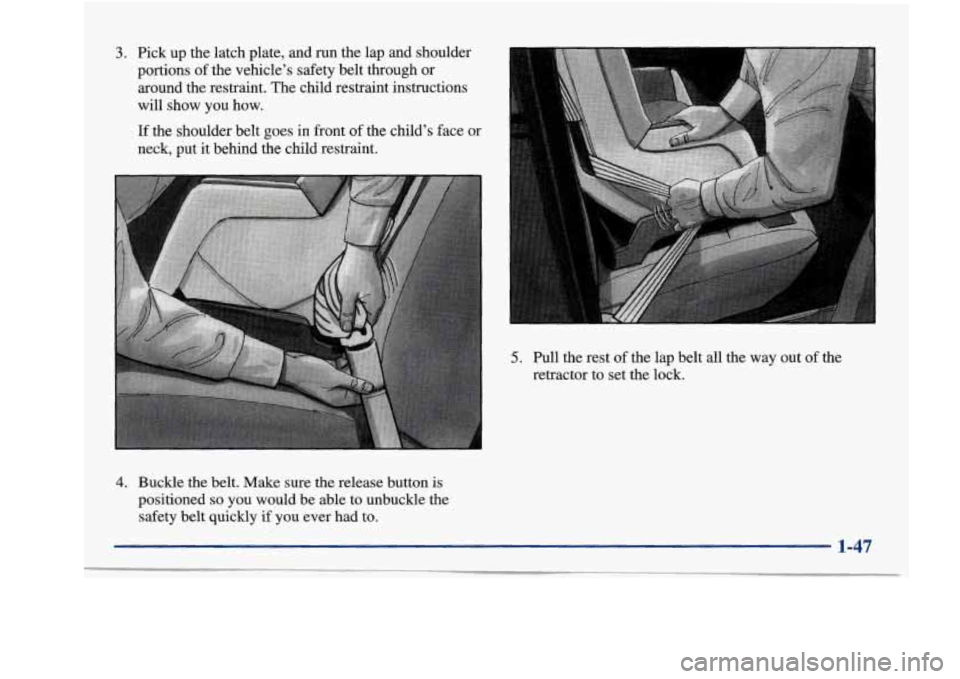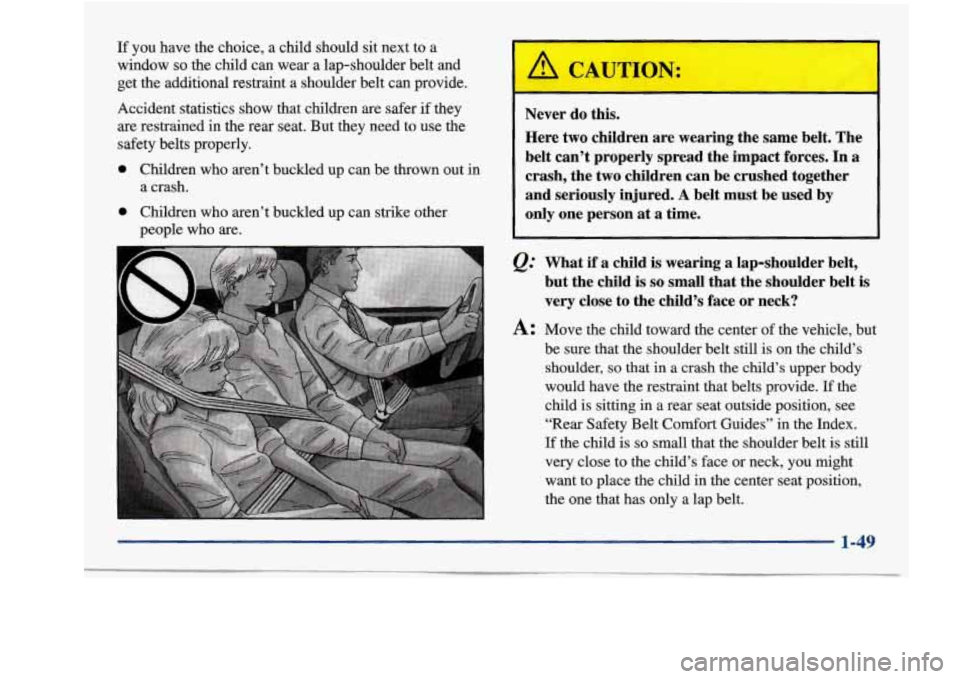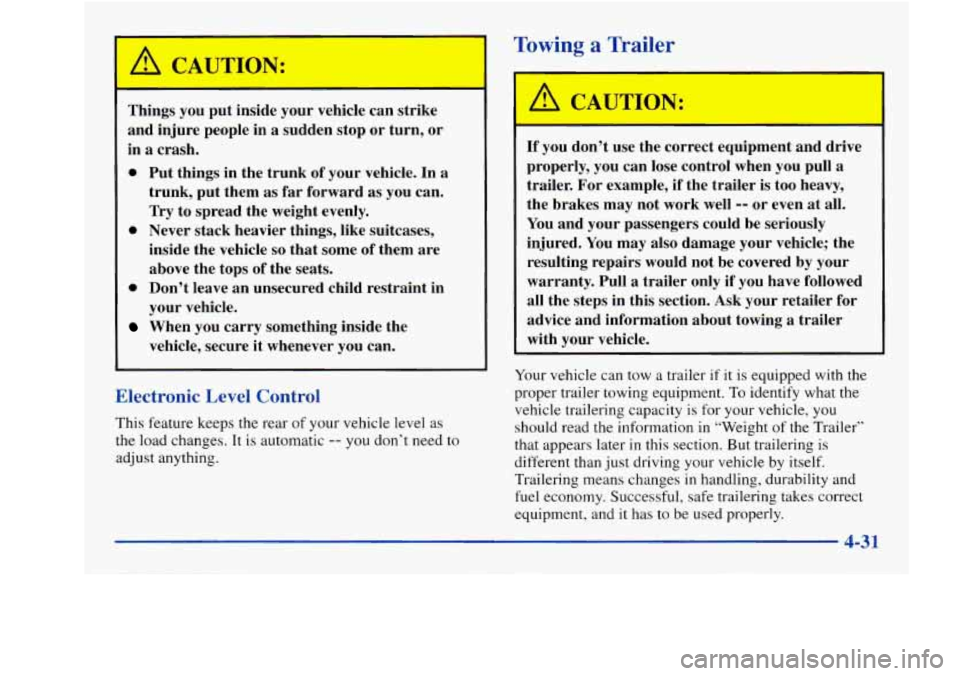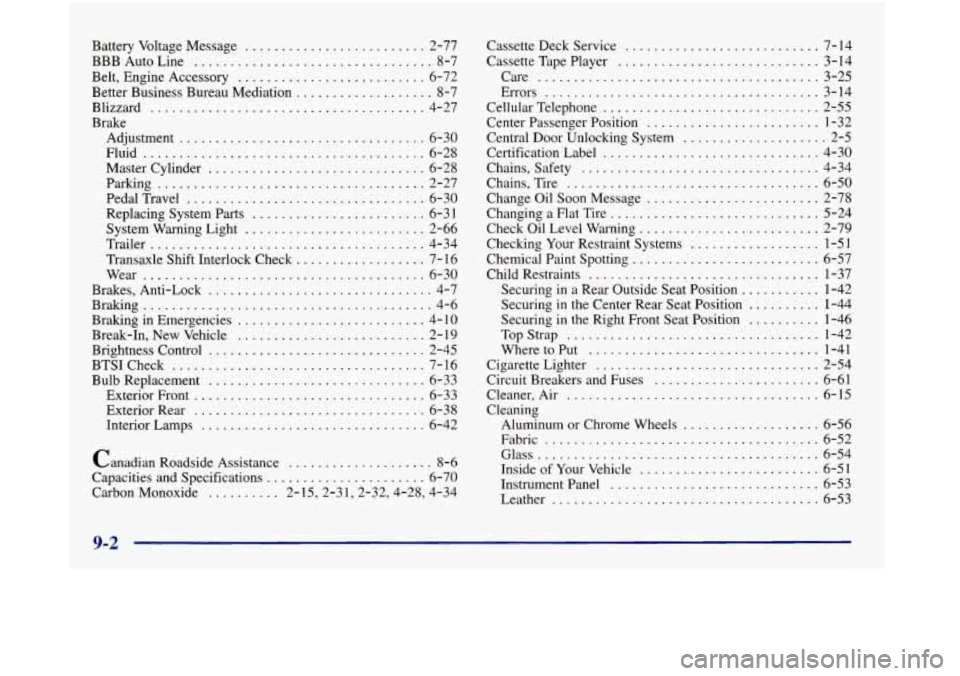child restraint Oldsmobile Aurora 1998 s User Guide
[x] Cancel search | Manufacturer: OLDSMOBILE, Model Year: 1998, Model line: Aurora, Model: Oldsmobile Aurora 1998Pages: 380, PDF Size: 19.75 MB
Page 54 of 380

Top Strap If your child restraint has a top strap, your retailer can
obtain
a kit with anchor hardware and installation
instructions specifically designed for this vehicle. The
retailer can then install the anchor for you. In Canada,
this work will be done
for you free of charge. Or, you
may install the anchor yourself using the instructions
provided in the
kit.
Securing a Child Restraint in a Rear
Outside Seat Position
If your child restraint has a top strap, it should be
anchored.
If you need to have an anchor installed, you
can
ask your Aurora retailer to put it in for you. If you
want to install
an anchor yourself, your retailer can tell
you how
to do it.
Canadian law requires that child restraints have a top
strap, and that the strap be anchored. You’ll
be using the lap-shoulder belt. See the earlier
part about the top strap
if the child restraint has one. Be
sure to follow the instructions that came with the child
restraint. Secure the child in the child restraint when and
as
the instructions say.
1. Put the restraint on the seat.
1-42
Page 55 of 380

2. Pick up the latch plate, and run the lap and shoulder
portions of the vehicle’s safety belt through or
around the restraint. The child restraint instructions
will show you how.
3. Tilt the latch plate to adjust the belt if needed.
If the shoulder belt goes in front of the child’s face or
neck, put it behind the child restraint.
4. Buckle the belt. Make sure the release button is
positioned
so you would be able to unbuckle the
safety belt quickly if you ever had to.
1-43
Page 56 of 380

5. To tighten the belt, pull up on the shoulder belt while
you push down on the child restraint. If you're using
a forward-facing child restraint, you may find it
helpful to use your knee to push down on the child
restraint as you tighten the belt.
6. Push and pull the child restraint in different
directions
to be sure it is secure.
To remove the child restraint, just unbuckle the vehicle's
safety belt and let it
go back all the way. The safety belt
will move freely
again and be ready to work for an adult
or larger child passenger.
Securing a Child Restraint in the Center
Rear Seat Position
You'll be using the lap belt. Be sure to follow the
instructions that came with the child restraint. Secure
the child in the child restraint when and as the
instructions say.
See the earlier
part about the top strap if the child
restraint has one.
1-44
Page 57 of 380

1. Make the belt as long as possible by tilting the latch
2. Put the restraint on the seat.
3. Run the vehicle’s safety belt through or around the
restraint. The child restraint instructions
will show
you
how.
plate and pulling it along the belt.
4. Buckle the belt. Make sure the release button is
positioned
so you would be able to unbuckle the
safety belt quickly if you ever had to.
5. To tighten the belt, pull its free end while you push
down
on the child restraint. If you’re using a
forward-facing child restraint, you may find it
helpful to use your knee to push
down on the child
restraint as you tighten the belt.
1-45
Page 58 of 380

6. Push and pull the child restraint in different
directions to be sure it is secure.
To remove the child restraint, just unbuckle the vehicle’s
safety belt.
It will be ready to work for an adult or larger
child passenger.
Securing a Child Restraint in the Right
Front Seat Position
n
u
Your vehicle has a right front passenger air bag. Never
put a rear-facing child restraint in this seat. Here’s why:
A child in a rearfacing child restraint can be
seriously injured or killed
if the right front
passenger’s air bag inflates, even though your
vehicle has reduced-force frontal
air bags. This is
because the back of the rear-facing child
restraint would be very close to the inflating
air
bag. Always secure a rear-facing child restraint
in the rear seat.
You’ll be using the lap-shoulder belt. See the earlier part
about the top strap if the child restraint has one. Be sure
to follow the instructions that came with the child
restraint. Secure the child in the child restraint when and
as the instructions say.
I. Because your vehicle has a right front passenger air
bag, always move the seat
as far back as it will go
before securing a forward-facing child restraint. (See
“Seats”
in the Index.)
2. Put the restraint on the seat.
Page 59 of 380

3. Pick up the latch plate, and run the lap and shoulder
portions of the vehicle’s safety belt through or
around the restraint. The child restraint instructions
will show you how.
If the shoulder belt goes in front of the child’s face or
neck, put it behind the child restraint.
5. Pull the rest of the lap belt all the way out of the
retractor to set the lock.
4. Buckle the belt. Make sure the release button is
positioned so you would be able to unbuckle the
safety belt quickly
if you ever had to.
1-47
Page 60 of 380

6. To tighten the belt, feed the lap belt back into the
retractor while you push down on the child restraint.
You may find it helpful to use your knee to push
down on the child restraint as
you tighten the belt.
7. Push and pull the child restraint in different
directions to be sure
it is secure.
To remove the child restraint, just unbuckle the vehicle’s
safety belt and let
it go back all the way. The safety belt
will move freely again and be ready to work for an adult
or larger child passenger.
Larger Children
Children who have outgrown child restraints should
wear the vehicle’s safety belts.
Page 61 of 380

If you have the choice, a child should sit next to a
window
so the child can wear a lap-shoulder belt and
get the additional restraint
a shoulder belt can provide.
Accident statistics show that children
are safer if they
are restrained in the rear seat. But they need to use the
safety belts properly.
0 Children who aren’t buckled up can be thrown out in
0 Children who aren’t buckled up can strike other
a crash.
people who are.
Never do this.
Here two children are wearing the same belt. The
belt can’t properly spread the impact forces. In
a
crash, the two children can be crushed together
and seriously injured.
A belt must be used by
only one person at a time.
&.’ What if a child is wearing a lap-shoulder belt,
but the child is
so small that the shoulder belt is
very close to the child’s face
or neck?
A: Move the child toward the center of the vehicle, but
be sure that the shoulder belt still is on the child’s
shoulder,
so that in a crash the child’s upper body
would have the restraint that belts provide. If the
child is sitting in a rear seat outside position, see
“Rear Safety Belt Comfort Guides” in the Index.
If the child is so small that the shoulder belt is still
very close to the child’s face or neck, you might
want to place the child in the center seat position,
the one that has only a lap belt.
1-49
Page 209 of 380

A CAUTION:
Things you put inside your vehicle can strike
and injure people in
a sudden stop or turn, or
in
a crash.
0 Put things in the trunk of your vehicle. In a
trunk, put them as
far forward as you can.
Try to spread the weight evenly.
inside the vehicle
so that some of them are
above the tops of the seats.
0 Don’t leave an unsecured child restraint in
your vehicle.
When you carry something inside the
vehicle, secure it whenever you can.
0 Never stack heavier things, like suitcases,
Electronic Level Control
This feature keeps the rear of your vehicle level as
the load changes. It
is automatic -- you don’t need to
adjust anything.
Towing a Trailer
A’ CAUTION:
If you don’t use the correct equipment and drive
properly, you can lose control when you pull
a
trailer. For example, if the trailer is too heavy,
the brakes may not work well
-- or even at all.
You and your passengers could be seriously
injured. You may also damage your vehicle; the
resulting repairs would not be covered by your
warranty. Pull a trailer only if you have followed
all the steps in this section.
Ask your retailer for
advice and information about towing a trailer
with your vehicle.
Your vehicle can tow a trailer
if it is equipped with the
proper trailer towing equipment. To identify what the
vehicle trailering capacity is for your vehicle, you
should read the information in “Weight
of the Trailer’’
that appears later
in this section. But trailering is
different than just driving your vehicle by itself.
Trailering means changes
in handling, durability and
fuel economy. Successful, safe trailering takes correct
equipment, and
it has to be used properly.
4-31
Page 364 of 380

Battery Voltage Message ......................... 2-77
BBB Auto Line
................................. 8-7
Belt. Engine Accessory
.......................... 6-72
Better Business Bureau Mediation
................... 8-7
Blizzard
...................................... 4-27
Brake Adjustment
.................................. 6-30
Fluid
....................................... 6-28
Master Cylinder
.............................. 6-28
Parkmg
..................................... 2-27
PedalTravel
................................. 6-30
Replacing System Parts
........................ 6-3 1
System Warning Light
......................... 2-66
Trailer
...................................... 4-34
Transaxle Shift Interlock Check
.................. 7- 16
Wear
....................................... 6-30
Brakes. Anti-Lock
............................... 4-7
Braking
........................................ 4-6
Braking in Emergencies
.......................... 4-10
Break-In. New Vehicle
.......................... 2- 19
Brightness Control
.............................. 2-45
BTSICheck
................................... 7-16
Bulb Replacement
.............................. 6-33
Exterior Front
................................ 6-33
Exterior Rear
................................ 6-38
Interior Lamps
............................... 6-42
Canadian Roadside Assistance
.................... 8-6
Capacities and Specifications
...................... 6-70
Carbon Monoxide
.......... 2- 15. 2.3 1.2.32.4.28. 4.34 Cassette
Deck Service
........................... 7-14
Cassette Tape Player
............................ 3-14
Care
....................................... 3-25
Errors
...................................... 3-14
Cellular Telephone
.............................. 2-55
Center Passenger Position ........................ 1-32
Central Door Unlocking System
.................... 2-5
Certification Label .............................. 4-30
Chains. Safety
................................. 4-34
Chains. Tire
................................... 6-50
Change Oil Soon Message
........................ 2-78
Changing a Flat Tire
............................. 5-24
Check Oil Level Warning
......................... 2-79
Checking Your Restraint Systems
.................. 1-51
Chemical Paint Spotting
.......................... 6-57
Child Restraints ................................ 1-37
Securing in a Rear Outside Seat Position
........... 1-42
Securing in the Center Rear Seat Position
.......... 1-44
Securing in the Right Front Seat Position
.......... 1-46
TopStrap
................................... 1-42
WheretoPut
................................ 1-41
Cigarette Lighter
............................... 2-54
Circuit Breakers and Fuses
....................... 6-61
Cleaner. Air
................................... 6-15
Cleaning Aluminum or Chrome Wheels
................... 6-56
Fabric
...................................... 6-52
Glass
....................................... 6-54
Inside of
Your Vehicle ......................... 6-51
Instrumentpanel
............................. 6-53
Leather
..................................... 6-53
9-2